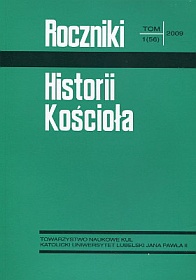The Resurrected Body in the Teachings of Apostolic Fathers and of St Justin
Abstract
The article presents the teaching about the resurrected body in the 2nd century A. D. (Apostolic Fathers, Justin, Pseudo-Justin), up to the moment of the appearance of the first treatises devoted exclusively to resurrection; they were written by Athenagoras, Tertulian or Origen at the break of the 2nd century.
On the basis of analysis of source texts the author puts forth the following theses:
1. The conviction about Christ’s resurrection was transmitted as one of the main truths of faith that prophesized raising of the dead, although the argument also appeared that referred to the Incarnation of Logos as the event giving the human body exceptional dignity, as well as stressed the role of God the Father as the Author of the new creature in the ultimate times.
2. Universality of resurrection as an act preceding the last judgment did not raise doubts in the authors of that period; however, they stressed rather the theological meaning and the salutary context of resurrection - that is, they understood it in the strict sense as the fact that just people will gain a new life in its fullness.
3. In some authors, especially in St Justin, the millenary context can be seen, suggesting the existence of resurrection for the just, who will live in a thousand-year kingdom that will still be an earthly, but already renewed one; this resurrection will be supplemented by the fact that people will gain new features, proper for eternal life, which can be received only after bringing back to life all the remaining people deserving eternal punishment in ultimate times.
4. In the discussed period spiritual understanding of resurrection was important. It was believed that in fact it begins with the baptism, and in ultimate times it only will be confirmed and supplemented by returning to human bodies. Moral conditions for receiving the new full life were important. Only those ones would attain it who would ‘keep their bodies chaste’; that is who would be faithful in their earthly lives to the grace received at the baptism.
5. The authors writing in that period were not particularly interested in anthropology. From the middle of the 2nd century the dualism of Hellenic origin was in fact typical. It emphasized that man consists of an immortal soul and a mortal body; however, this relation is not commented on so widely as in later apologetic writings.
6. Christian authors of the first two centuries A. D. most often used the phrase „ ἀνάστασιϛ νεκρῶν” for describing resurrection, and when they meant the resurrected body they more frequently used the term „ σάρξ” than „σῶμα”, although these terms had similar meanings and they were used interchangeably.
7. Authors of that period did not consider the features of the resurrected body in detail. First of all they emphasized its immortality (ἀθανασία) and imperishableness (ἀφθαρσία).
8. Most works coming from the discussed period contain criticism of the doketistic views or ones rejecting resurrection, which proves that from the very beginning there was a current in the Church that questioned the possibility that the human body could return to life.
References
Boliek L., The Resurrection of the Flesh. A Study of a Confessional Phrase, Amsterdam 1962.
Eijk T.H.C. van, La résurrection des morts chez les Pères Apostoliques, (Théologie historique 25), Paris 1974.
Giordano O., L ’escatologia della Didache, w: Oikoumene. Studi in onore del Concilio Vaticano II, Catania 1963, s. 121-139.
O’Hagan A.P., Material Recreation in the Apostolic Fathers, (Texte und Untersuchungen 100), Berlin 1968.
Hallstrôm G. af, Carnis resurrectio: the Interpretation of a Credal Formula, Helsinki 1988.
Kalinkowski S., Wczesnochrześcijańska apologia grecka (II-V w.). Zarys rozwoju, w: Atenagoras z Aten, Prośba za chrześcijanami. O zmartwychwstaniu umarłych, Warszawa 1985, s. 5-23.
Lona H.E., Ps. Justinus „De resurrectione” und die altchristlichen Auferstehungsapologetik, „Salesianum” 51(1989), s. 691-768.
Lona H.E., Über die Auferstehung des Fleisches. Studien zur frühchristlichen Eschatologie, Berlin-New York 1993.
II Millenarismo - testi dei secoli I-II, red. C. Nardi, Fiesole 1995.
La résurrection chez les Pères, red. J.M. Prieur, (Cahiers de Biblia Patristica 7), Strasbourg 2003.
Pouderon B., Doré J., Les Apologistes chrétiens et la culture grecque, Paris 1998.
Pietras H., Eschatologia Kościoła pierwszych czterech wieków, Kraków 2007.
Setzer C., Resurrection of the Body in Early Judaism and Early Christianity. Doctrine, Community, and Self-Definition, Boston-Leiden 2004.
Copyright (c) 2009 Roczniki Historii Kościoła

This work is licensed under a Creative Commons Attribution-NonCommercial-NoDerivatives 4.0 International License.

